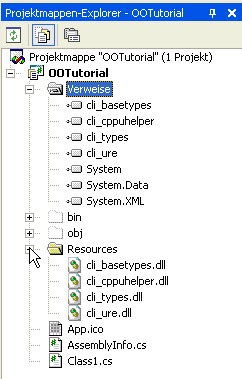|
using System;
/*
* Use the Reflection namespace to get our Com objects
*/
using System.Reflection;
namespace OpenOfficeAppRefl
{
class OpenOfficeApp
{
//Define a file name. Change this to an existing path!
private static string FileName = @"F:\odtfiles\test.odt";
[STAThread]
static void Main(string[] args)
{
//Create a new ServiceManager Type object
Type tServiceManager = Type.GetTypeFromProgID("com.sun.star.ServiceManager", true);
//Create a new ServiceManager Com object using our
//ServiceManager type object
object oServiceManager = System.Activator.CreateInstance(tServiceManager);
//Create our Desktop Com object
object oDesktop = Invoke(oServiceManager,
"createinstance",
BindingFlags.InvokeMethod,
"com.sun.star.frame.Desktop");
//Create an array for our load parameter
Object[] arg = new Object[4];
arg[0] = "private:factory/swriter";
arg[1] = "_blank";
arg[2] = 0;
arg[3] = new Object[] {};
//Create our new blank document
object oComponent = Invoke(oDesktop,
"loadComponentFromUrl",
BindingFlags.InvokeMethod,
arg
);
//Create an empty array for the getText method
arg = new Object[0];
//Get our Text Com object
Object oText = Invoke(oComponent,
"getText",
BindingFlags.InvokeMethod,
arg
);
//Write the text to the document
Invoke(oComponent,
"getText",
BindingFlags.InvokeMethod,
new Object[1] {"Hello I'm the first text!"}
);
//Create an array for the storeToUrl method
arg = new Object[2];
arg[0] = PathConverter(FileName);
arg[1] = new Object[0] {};
//Save our document
Invoke(oComponent,
"storeToUrl",
BindingFlags.InvokeMethod,
arg
);
Console.WriteLine("Our first document created via Reflection is done!");
}
/// <summary>
/// Convert into OO file format
/// </summary>
/// <param name="file">The file.</param>
/// <returns>The converted file</returns>
private static string PathConverter(string file)
{
try
{
file = file.Replace(@"\", "/");
return "file:///"+file;
}
catch(System.Exception ex)
{
throw ex;
}
}
/// <summary>
/// Create a new Com object.
/// </summary>
/// <param name="obj">The object to call invoke on.</param>
/// <param name="method">The methodname to call</param>
/// <param name="binding">One of the BiningFlags Enumertion</param>
/// <param name="par">The params for the invoke method call</param>
/// <returns></returns>
public static object Invoke(object obj,string method, BindingFlags binding,params object[] par)
{
return obj.GetType().InvokeMember(method,binding,null,obj,par);
}
}
}
|
